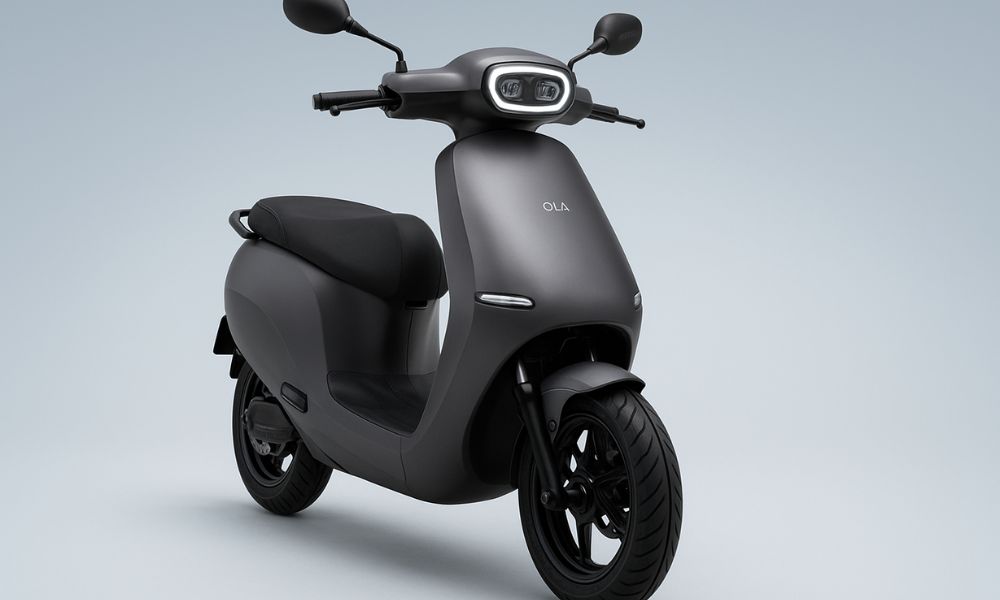After attracting investment in April 2021, Ola Electric Mobility, one of the leading electric two-wheeler manufacturers in India, continues to cause a stir in the stock market. Investors are curious about the company’s next step. The emergence of prolonged EV adoption, enhancements to production capacity, and brand presence place Ola Electric at the apex of the clean mobility movement in India, one of the most lucrative electric mobility markets in the world. Here is what you need to know about Ola Electric Mobility’s share price, performance, and what investors should watch for in the coming months.
Ola Electric Mobility: Current Market Overview
Ola Electric Mobility, a spin-off from the ride-hailing giant Ola (ANI Technologies), has quickly become an important player in India’s electric scooter market. Since going public, the share price for Ola Electric has fluctuated reflecting both optimism around India’s EV ecosystem, but the realities of manufacturing larger amounts at an appropriately profitable level.
In the most recent trading sessions (early November 2025), Ola Electric’s shares have shown modest volatility, trading in the range of ₹285–₹305, depending on overall market sentiment and trends in the EV sector.
While analysts expect price fluctuation in the near-term, the longer-term prospects remain strong and promising due to an increase in production capacity, new models scheduled for release, and possible export sales.
Key Drivers of Ola Electric’s Share Performance
| Factor | Impact on Share Price |
|---|---|
| Strong EV Demand in India | Positive – increasing adoption boosts sales growth |
| New Product Launches (S1X, S1 Pro Gen 2) | Positive – enhances product portfolio and market share |
| Battery Technology Advancements | Positive – improves efficiency and reduces production costs |
| Government EV Incentives (FAME-II, PLI) | Positive – supports margins and affordability |
| High Competition (Ather, TVS, Bajaj) | Neutral to Negative – may pressure pricing |
| Profitability and Cost Management | Crucial – investors watching for sustained margins |
Ola Electric’s recent focus on in-house battery cell manufacturing and cost optimization is expected to improve its margins over time, making it more attractive to institutional investors.
Financial and Production Highlights
- Revenue Growth: Year-over-year revenue growth is expected as Ola Electric is now supported by robust sales of its S1 Pro and S1 Air models.
- Production Capacity: The company is continuously ramping up production capacity at its Future Factory in Krishnagiri, Tamil Nadu, which is currently still one of the largest electric two-wheeler factories in the world.
- Exporting Models: Ola has also started to look at global EV markets, especially in Southeast Asia and Europe as a means of diversifying its operations, and to shore-up revenue.
- Battery Research & Development: The newly forthcoming Ola Gigafactory, dedicated to battery production, is anticipated to lessen dependency on imports, and vertically integrate its production cycle.
All of this effort is an indication of the strategic capstone operations meant to drive extended growth, all in lock-step with India’s EV-imposed mission of 2030.
Investor Sentiment and Market Outlook
Investors remain cautiously optimistic overall on Ola Electric Mobility. Analysts believe that although the company is early in its listed company journey, its brand power and initial market leadership positions it well.
There are meaningful challenges to consider that could affect near-term performance:
- High capital expenditures on new factories and R&D could constrain near-term profits.
- Intense pricing competition in the EV space may pressure some margins.
- Slow development of EV infrastructure may limit rapid expansion of small cities.
Still, with government support for EV adoption and a strong innovation pipeline, analysts expect Ola will remain a leading EV to look for in terms of stocks in the coming quarters.
Technical View: Ola Electric Share Price Trend
From a technical perspective, Ola Electric’s share has shown a steady consolidation pattern after its initial listing volatility.
- Current Price Range: ₹285–₹305
- Immediate Support: ₹275
- Resistance Levels: ₹315 and ₹335
- Short-Term View: Sideways to positive, with buying interest near support levels
- Long-Term View: Bullish outlook based on strong growth potential and market expansion
Investors with a long-term horizon may consider accumulating on dips, especially if the company continues to demonstrate strong quarterly earnings growth.
Future Outlook: What to Expect in Coming Quarters
- Expansion of Product Footprint: Ola Electric is expected to introduce affordable mass-market e-scooters and potentially an electric motorcycle by mid-2026.
- Battery Manufacturing: The in-house Ola Gigafactory may be commissioned soon, helping lower costs and improve efficiency.
- IPO-Driven Growth Story: As a result of its strengthening brand equity and innovation advantage, analysts expect Ola to expand globally and generate profit in the next few fiscal years.
- EV Ecosystem: Ola’s focus on end-to-end EV solutions — from charging to financing — may drive customer retention.
Combining these advances with the support of favorable policy conditions places Ola Electric in a position to be a leader in the global electric mobility transition.
Benefits of Investing in Ola Electric Mobility
1. Strong Market Leadership in India’s EV Segment
Ola Electric has quickly become a leader in the electric two-wheeler category, often being among the most popular brands in India. Ola’s best-known models, the Ola S1 Pro, S1 Air and S1X, are in the top leads of EV scooter sales because of their unique design, performance, and low price-point.
This leadership has given Ola a first-mover advantage to develop brand awareness and customer loyalty before many competitors have been able to grow.
2. Strategic Government Support and EV-Friendly Policies
Ola Electric takes direct advantage of the Indian government’s EV policies, including FAME-II and the PLI scheme. Collectively, these programs lower production costs, support local manufacturing, and increase consumer subsidies, thereby increasing overall sales and profitability. Furthermore, India’s commitment to achieving 30% EV adoption rates by 2030 offers long-term policy certainty to support Ola’s growth ambitions.
3. Focus on Innovation and Advanced R&D
What distinguishes the company is its commitment to R&D and innovation. Ola Electric is investing significantly in battery cell research and development, AI-enabled software for vehicles, and connected mobility solutions.
The company’s new Ola Gigafactory, for battery manufacturing at scale, will help reduce reliance on imports, minimize costs, and enhance efficiencies — a key differentiator in the EV industry.
4. Sustainable and ESG-Aligned Investment
Ola Electric is an excellent example of an ESG investment in terms of environmental, social, and governance. The global shift to less polluting energy sources makes it easy for such companies to get the attention of the investors who care about decarbonization and sustainable mobility the most.
Ola Electric is making India’s green mission a reality and is therefore considered an attractive option for sustainability-oriented portfolios that can eventually bring in institutional capital, through the company’s long-term strategy of reducing carbon emissions and supporting renewable energy adoption.
5. Expanding Global Footprint and Diversified Growth Strategy
Besides India, Ola Electric is investigating opportunities in Southeast Asia, Europe, and Latin America to establish itself as a global EV mobility brand. This will mitigate over-reliance on the Indian market and provide a wider revenue opportunity. Additionally, entering the electric motorcycle and four-wheeler segments will diversify the product range and improve competitive positioning.
Drawbacks and Risks of Investing in Ola Electric Mobility
1. Profitability Concerns and High Operating Costs
Ola Electric experienced impressive revenue growth, but it is early in its profitability lifecycle. As the company continues to heavily invest in research and development (R&D), manufacturing capacity expansion, and marketing costs, the bottom line is impacted.
Currently, there is still significant capital expenditure (CapEx) associated with the ongoing construction of the Ola Gigafactory, along with adding new retail and service locations.
While necessary for future growth, this creates margin pressures in the short term and will lead to quarterly earnings volatility that may concern investors looking for stability.
2. Rising Competition in the EV Two-Wheeler Segment
The market for electric scooters in India is turning very competitive, where the likes of Ather Energy, TVS iQube, Bajaj Chetak, and Hero Vida are quick to expand their product lines.
These established companies not only have extensive sales networks but also substantial financial resources and high consumer trust built over time.
The fierce competition may pressure Ola Electric to resort to price reduction or higher marketing expenditure, thus impacting profits. Besides, it is observed that consumer preferences in the technology-driven electric vehicle arena can change suddenly; hence, brand loyalty in the e-mobility sector remains quite fragile compared to the case of traditional car manufacturers.
3. EV Infrastructure and Charging Ecosystem Challenges
One of the greatest challenges to widespread EV adoption in India is still not having a sufficiently strong charging infrastructure. While Ola has its own Hypercharger network, it only covers a limited range of locations (i.e., cities and highways).
This makes it seem difficult to travel long distances and discourages many potential buyers from switching to EVs. The level of reliable electricity and standardization of technology for charging also remains a general challenge that will prevent much growth for EVs in India, and indirectly limit the potential growth of Ola Electric.
4. Market Volatility and Dependence on Policy Support
The stock of Ola Electric is, just like to a large extent, determined by speculation and the overall mood of the investors. The company’s share price is highly sensitive to changes in government policy, worldwide electric vehicle trends and quarterly earnings because it is in a developing industry.
A case in point is if the government were to cut or stop giving out support like the FAME-II subsidies, the consumer demand would probably decline due to increased prices for the products.
Moreover, the changes in the prices of the raw materials (mostly lithium and nickel for batteries) might influence the production costs.
Thus, the investors will have to deal with the short-term uncertainty while the company’s long-term outlooks are still bright.
Final Verdict
The Ola Electric Mobility stock is still one of the most exciting EV stocks in India’s emerging electric mobility space. With strong demand growth, technology advancements, and planned investments in battery manufacturing, Ola Electric is positioning itself for growth.
Although some volatility is expected in the near-term, the long-term outlook is positive for investors who believe in the story of EV growth and the company’s ability to lead the charge in bringing electric mobility into India’s future.



